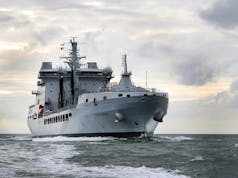The Type 45 Destroyer has now departed Gibraltar and is tasked with protecting American aircraft carriers in the fight against Islamic State.
Daring will take over the responsibilities of HMS Defender, another of the UK’s six Type 45 destroyers, which returned to Portsmouth at the start of July following a nine-month operation.
Defence Secretary Michael Fallon said:
“All three armed services are making a vital contribution to defeating Daesh.
RAF aircraft are hitting the terrorists daily on the ground; the Army is providing counter-explosives training to Iraq troops; the Royal Navy helps protect coalition carriers in the Gulf as they launch strikes.”
Gibraltar was the ships first stop on her journey out to the Middle East. Also alongside in Gibraltar was RFA Mounts Bay and HMS Diamond.

This comes as the cost of fixing the propulsion issues on the Type 45 Destroyer fleet has become widely known.
In 2015, the Ministry of Defence acknowledged that the vessels propulsion system, specifically, the Northrup Grumman intercooler was experiencing reliability issues, previously reported as nothing more than “teething troubles”.
A staggered refit was also announced, which will involve cutting into the ships’ hulls and fitting additional diesel generation capacity, this has become known as Project Napier.
According to the Royal Institute of Naval Architects:
“Project Napier was established in 2014 with two core work strands. The first of these, known as the Equipment Improvement Plan (EIP), is continuing efforts to enhance system reliability and to meet the original design intent in the near term.
The second component of Project Napier is a longer term Power Improvement Plan (PIP), intended to improve overall system resilience by adding upgraded diesel generators to provide the electrical generation capacity required to meet the overwhelming majority of propulsion and ship power requirements without reliance on WR-21.”
Project Napier will cost £280 million.
The reliability issues with the intercooler lead to occasional near-complete power generation failures, temporarily disabling not only propulsion, but power generation for weapons, navigational systems, and other purposes, leaving the ships vulnerable to “total electric failure”.
HMS Daring’s engines failed in the mid-Atlantic in 2010 and had to be repaired in Canada, with further repairs for engine failure in 2012 in Bahrain after it encountered propulsion problems while on patrol off the coast of Kuwait.
In June this year, Ministry of Defence officials admitted that the ships were breaking down because the intercooler could not cope with the warm waters of the Gulf.
Manufacturers Rolls-Royce of the fully functioning, non-problematic turbines said that the intercoolers for the WR-21 had been built as specified, but that conditions in the Middle East were not “in line with these specs”.
The MoD said:
“The Type 45 was designed for world-wide operations, from sub-Arctic to extreme tropical environments, and continues to operate effectively in the Gulf and the South Atlantic all year round.”
Current First Sea Lord Admiral Philip Jones clarified:
“WR-21 gas turbines were designed in extreme hot weather conditions to what we call “gracefully degrade” in their performance, until you get to the point where it goes beyond the temperature at which they would operate… we found that the resilience of the diesel generators and the WR-21 in the ship at the moment was not degrading gracefully; it was degrading catastrophically, so that is what we have had to address.”
It should be noticed that despite the problems, the Royal Navy has been able to deploy Type 45 destroyers in nine-month cycles to the Gulf region where temperatures are high with little fault.













Protecting the carrier from what?
From things they can’t protect themselves against.
From the unexpected.
As we know carriers are insanely expensive and more so when you add the airwing and crew. It’s highly unlikely that Daesh would get gear to be able to take on a carrier, but better to be safe, since highly unlikely is not impossible.
However, i suspect our destroyer is going there for PR reasons, since there is no way the US would trust the defence of their assets to a destroyer that has power issues. Especially considering what they said after the attack on the base in Afgan and how damning they were on trusting Brits for secruity afterwards.